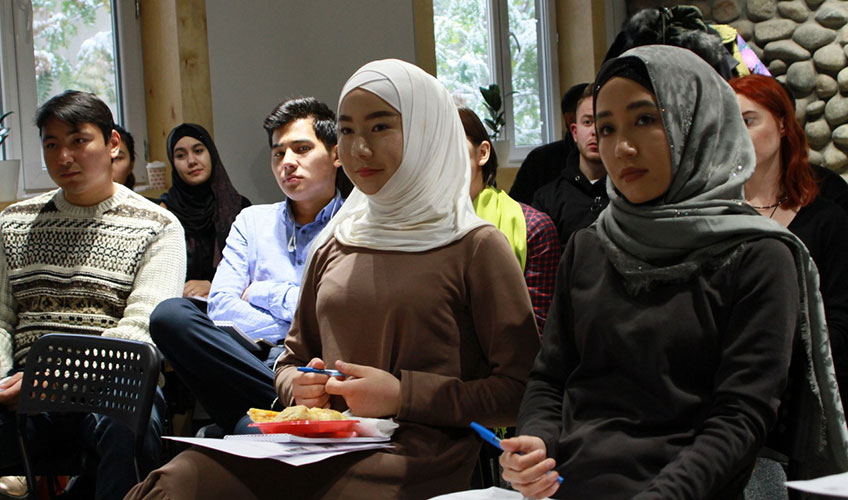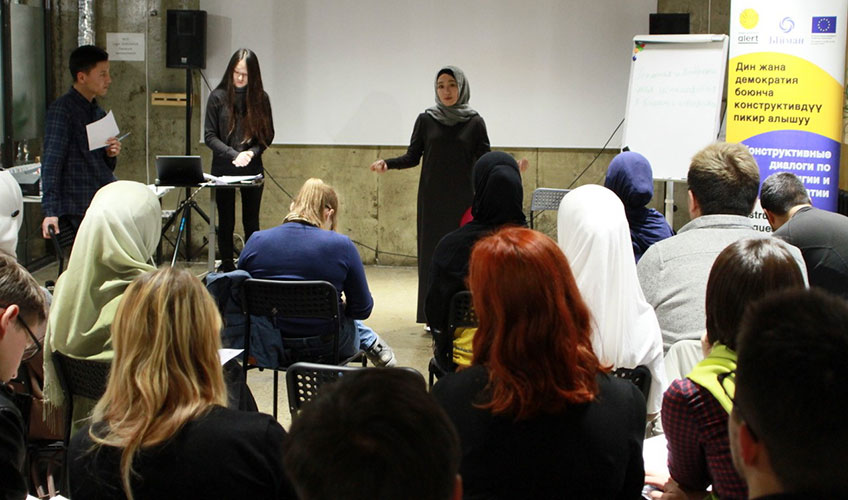Real and imagined islamophobia in Bishkek
International Alert’s series of discussion clubs on religion and democracy in Kyrgyzstan continued in October by looking at the issue of real and imagined Islamophobia in Bishkek and its outskirts.

The clubs are held as part of our ongoing project, ‘Constructive dialogues on religion and democracy’, funded by the European Union, which brings together religious leaders, civil society members, journalists and government officials to learn about and discuss key issues affecting religion and democracy in the country.
International Alert Kyrgyzstan’s Project Manager Rasul Momunaliev presented statistics on Islamophobia from research conducted for the project by graduate researchers Urmat Kaliyev and Isaura Maseitova. The study examined the phenomenon of Islamophobia from two perspectives: from the wider population and from Muslims.
According to the research, Islamophobia in Kyrgyzstan is initially formed on the basis of visual images associated with the religion, such as the hijab on women and beards on men.
The older generation that grew up under Soviet anti-religious propaganda was found to be the most negative towards Islam and Muslims. Islamophobia is present among young people too, but to a lesser extent.
Interestingly, Islamophobia in Bishkek has a very strong gender dimension, with women on both sides of the confrontation: non-Muslim women were more Islamophobic than their male counterparts, and Muslim women suffered more from Islamophobia than Muslim men.
Islamophobia in Bishkek also manifests itself in issues of identity formation and understanding. At the latest session, a student and a Taekwondo trainer, Razia Mamasharipova (pictured presenting below), spoke about the perception of Muslim women in modern society.

Razia is a winner of the Universiade in Taekwondo and judo, a student of the International University Ata-Turk and a practicing Muslim. In her speech, Razia shared the difficulties she faces in everyday life because off the numerous stereotypes about Muslims and talked about some people’s prejudices towards the hijab and headscarf.
She also shared her experience of opening a Taekwondo hall for Muslim girls and her dream of opening a network of women’s sports halls where Muslim women, and women in general, can practice their sport.
Nuriza Sovetbekova, a Taekwondo master and national gold medallist in the sport, said that people perceive Muslim women differently. Some treat them with respect and understanding, but there are those who humiliate and insult them, even calling them terrorists.
Some people believe that women in Islam are not allowed to leave their house, work or study,” says Nuriza. “There are Muslim girls, of course, who themselves suffer from their own framework and the opinions of others. [But] for me personally, it’s normal to keep up everywhere: learn, conduct business and play sports. Generally, sports, according to the Quran, is ‘sunnah’, which means that sports are allowed in Islam; it is a blessing
For Aman Saliev, from the Institute of Strategic Analysis and Forecast at the Kyrgyz–Russian Slavic University, the main reason for Islamophobia, as with any such phobia, is a lack of education and understanding on it.
“The reason for almost all phobias of humanity, above all, is ignorance,” says Aman. “This in general causes wars and murders and a large number of other incidents that we are now witnessing.
“People are concerned that there has been an increase in Islamisation. Yes indeed, from the outside it may seem that the number of believers is growing exponentially. Yet the media generally speaks about the growing numbers of Muslims, while there is an increase in the number of believers of almost all denominations, especially Protestants.
People go to completely different doctrines and philosophies. Why is this happening? It’s just a process of finding yourself and we have absolute freedom of choice
The participants also included blogger and journalist Azat Toroev, who shared his thoughts on the pace of Islam and Islamophobia in the life of “global youth”, and journalist, TV presenter and researcher Zhamby Zhusubaliyeva, who spoke on the topic of ‘Speaking of Islam: Reflections of an inexperienced observer’.
This was the fifth such discussion club held since 2017. The clubs are held every three months based on research conducted by universities and youth centres in seven regions plus the cities of Bishkek and Osh. The discussions touch on issues of choice of religion and belief, the role of religion in a secular, democratic republic, relations between the state and religious institutions, and state policy regarding religion.
The themes of the previous sessions were: religious topics in the media and social networks and its impact on young people in Kyrgyzstan; the role of religion and religious organisations in a secular democratic country; religion and national traditions and religious tolerance in modern society; and interfaith cooperation in Kyrgyzstan.
About the project
The Constructive dialogue on religion and democracy project aims to maintain an open public dialogue on freedom of religion and belief, the role of religion in people’s lives, the relationship between state and religious institutions, as well as on national strategies on religion.
This project provides a platform on religious–secular dialogue, comprising of religious leaders, scholars, civil society members, journalists and government officials, to discuss key issues on religion and democracy in the country and to identify knowledge gaps.
In partnership with the Iyman Foundation, we trained clergymen to strengthen interfaith harmony and religious tolerance, preventing domestic violence and on gender issues, and civic participation in a secular, democratic society. Youth peer mentors were trained in facilitating conflict-sensitive topics, and 90 discussion clubs were held among youth throughout the country with the participation of about 3,000 participants.







